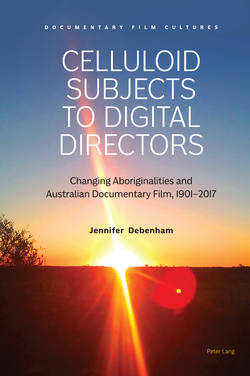Читать книгу Celluloid Subjects to Digital Directors - Jennifer Debenham - Страница 27
На сайте Литреса книга снята с продажи.
Background
ОглавлениеLife in Central Australia is the sixth in a series of twelve films made by the South Australian Board for Anthropological Research (SABAR) and the South Australian Museum (SAM) between 1926 and 1937. It records the daily interactions of scientists with the Warlpiri, the Ngarti and the Anmatjere people. The interwar years marked a period when anthropometric measurements were a key component of anthropological data ←33 | 34→gathering worldwide. Depicting the scientists as experts conducting tests and experiments with scientific objectivity and purpose, the film made at Cockatoo Creek in 1931, foregrounded the data collection as purposeful and methodical. The film is a snapshot that demonstrates the collection of biometric data and the praxis of scientific research conducted on Aboriginal people during this period. It emphasises (intentional or not) the contrast between Anglo Australians and the Warlpiri, the Ngarti and the Anmatjere people.
In the early twentieth century, Australia was considered an important site to study “primitive” human societies. However, government priorities meant that only meagre resources were available to finance anthropological research and Australian scientists turned towards the United States of America for support. In 1926, SABAR was established to attract funds from the Rockefeller Foundation.1 A joint venture between the University of Adelaide and the South Australian Museum, it drew together an eminent group of internationally renowned scientists, chaired by Professor John Burton Cleland. Cleland was a doctor of Pathology, who like many academics of his ilk at that time, had diverse interests in other discipline areas such as ornithology, botany and physical anthropology. Another executive member, Thomas Draper Campbell, outlined that their collective goal was to unlock many of the questions being raised about Aboriginal people, their origins and how they adapted both psychologically and physically to their environment.2
Their greater emphasis on physical anthropology was to a large extent due to the circumstances in which the medical school was established. From its inception, the school enjoyed close connections with the Museum and the South Australian health department. Key individuals such as Edward Stirling augmented a research culture that ensured the medical faculty developed an international reputation in research. Stirling, a Cambridge-trained evolutionist, was a member of the Horn Expedition ←34 | 35→where Spencer and Gillen met. In Adelaide, he carefully nurtured a rising generation of scholars to study the physical anthropology of Aboriginal peoples including Cleland and Draper Campbell and Robert Pulleine, an ear, nose and throat physician, all members of numerous SABAR expeditions. Ramsay Smith, head of the health department was an evolutionist interested in testing theories of hereditary and adaptation among the Aborigines in the nearby deserts. The other was Frederick Wood Jones, a Lamarckian evolutionist and comparative biologist whose enthusiastic collection of anthropometric data appears incongruent from a twenty-first-century perspective with his humanitarian sympathies for the poor condition of many Aboriginal peoples. These inconsistencies occur regularly in the writings of most of these men, revealing the difficulties of engaging the concept of race as a biological determinant of behaviour and technological development.
When the Rockefeller Foundation indicated their interest in funding Australian research of Aboriginal peoples in the early 1920s, competition intensified between Sydney and Adelaide universities. Adelaide believed they had an advantage over Sydney due to their close association with members of the Rockefeller board, the similarities of their research objectives and their closer proximity to central Australia where most Aboriginal people lived in remote communities. The Foundation provided funding to the Australian National Research Council (ANRC), the central research administration body in Australia to use as they saw fit. The ANRC, based in Sydney, made decisions about which research would be funded and how much of the funds the recipients would receive. Sydney’s newly established Chair of Anthropology made it the only university in Australia with an anthropology department and its inaugural incumbent, Alfred Reginald Radcliffe-Brown, advocated for a more social approach to anthropological research. Together with a new interest in the Pacific regions and Australia’s colony of New Guinea, Sydney’s convenient location promised new and bountiful anthropological fields to explore. The scientists at Adelaide were sorely disappointed. Although the Rockefeller board had recommended SABAR receive a portion of the funding through the ANRC, the scientists at Adelaide believed what they received was penury. A more direct approach was required.
←35 | 36→
SABAR’s research direction was closely aligned with the interests of Charles Davenport, head of the Eugenics Records Office at Cold Spring Harbor in the US. Davenport was a member of the influential US branch of the Galton Society3 which enjoyed strong connections with the Rockefeller Foundation board. The decision to establish the new chair of Anthropology at the University of Sydney rather than at University of Adelaide put the Galton Society’s request for eugenics studies in Australia in jeopardy. Davenport, aided by Yale University Professor Clark Wissler, pressed the Rockefeller board to ensure that part of their funding was reserved to support work at the University of Adelaide. In addition, SABAR also accessed direct funding from the Carnegie Corporation and Yale University via Clark Wissler who donated at least one of their film cameras4 as well as private donations. Much of the fieldwork was carried out by researchers from the University of Adelaide on a voluntary basis during their vacations.5 Collectively, the funds enabled the employment of a dedicated cinematographer on the expedition along with the latest film technology available; at least two cinematic cameras; a 35 mm and a 16 mm black-and-white silent format. Some footage of this expedition was recorded on the new Kodachrome 16 mm colour silent cinematic film indicating their access to and uptake of the very latest technology.6 Like Spencer and Gillen, the ←36 | 37→SABAR scientists were looking for “authenticity”. Although the authenticity they were seeking however, had more to do with biometric indicators.
